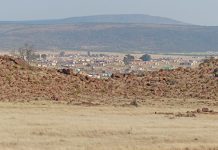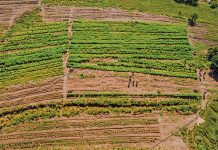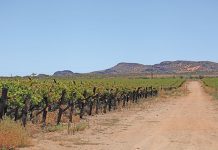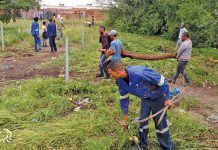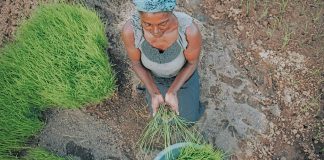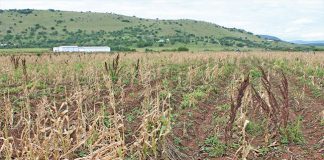Balmoral Holstein farmer Gerhard Landman is a farmer with a water crisis. This could also become the fate of numerous farmers who use the Olifants River for irrigation purposes. Landman’s property, Dwandzani lies amid numerous coal mines, which are known for the acid water they produce. Because of this year’s low rainfall the river that flows through his property, the Zaalklap, stopped flowing. However, on 2 May (Wednesday) the river – a tributary of the Olifants River – started flowing slowly.
By Thursday the water was white-turquoise, and on the Saturday it had turned reddish-brown. Landman’s Holsteins licked the water, but refused to drink, and the next day they started suffering from diarrhoea. The water’s pH measured between 2,7 and 2,9 – the same acidity as lemon juice. “All the fish, frogs, crabs and birds next to the river died,” Landman says. The water remained at a pH above 3,7 for about six weeks after the incident, according to Dr Jan Myburgh from the Department of Paraclinical Sciences at Onderstepoort. Landman and Myburgh both believe the high pH level is due to acidic water flowing from mines. This would explain the diarrhoea in the cattle, Myburgh says.
Sulphur is released during mining which mixes with air and water to create sulphuric acid. Heavy metals such as magnesium are diluted in the sulphuric acid, and magnesium combined with sulphite creates what is commonly known as Epsom salt – a great laxative. The incident was reported to both the Department of Water Affairs and Forestry (DWAF) and the Department of Minerals and Energy, but Landman says the response he received has not been very enthusiastic. He is currently hiring a water tanker for R1 000 a day to transport water from a fountain on his farm to his 120 cattle. This is also the main household water source, thus his home is without water for large parts of the day.
The farm’s dairy production dropped by a third at the beginning of May and, although it has picked up again, the farm is currently running at only 75% capacity to what it was running before the incident. International guidelines state that there should preferably not be more than 400mg of sulphates in every litre of drinking water. Landman’s water measured about 3 000mg per litre, according to Myburgh. Too much sulphate could lead to permanent brain damage in cattle. This is Landman’s situation in a nutshell and could be similar for other irrigation farmers below Loskop Dam. But before reaching the dam, it’s important to understand the pollution created further upstream.
Science of acidic water created in mining
“If we don’t stop passing the buck, doing more research and avoiding the real problem, we may well have an interesting, but negative, tourist attraction for the 2010 Soccer World Cup – the largest acid and toxic lake in Africa on one of the Mpumalanga Tourism and Parks Agency’s top three nature reserves,” says Mike Buchanan, an expert on mine pollution.
Acid mine drainage (AMD) is the biggest environmental problem facing the mining industry, says Buchanan. “The upper Olifants River above Loskop Dam is presently subjected to a severe prevalence of this phenomenon.” This is supported by DWAF research in an official document stating, “Mining, predominantly for coal, and other industrial activities in this area, are the main contributors to poor stream and riparian habitat conditions.” It goes on to state that the water’s poor quality is due to acid leachate which mainly comes from mines. “Low pH and high concentrations of dissolved salts are characteristics of streams in this section.” Because subsurface mining often progresses below the water table, water constantly needs to be pumped out of mines. When rocks are broken during the mining process, numerous minerals are released.
This includes sulphates such as pyrite, which also creates sulphuric acid. When a mine is no longer used, the process of pumping water ceases and the mine is flooded, producing even more acid water. Heavy metals dissolved by the acid in the Olifants River include magnesium, lead, aluminium, mercury and manganese. “This pollution has been going on for over 50 years and is worsening by the day,” Buchanan says, adding that there may be more water present in these old coal mines than in the Loskop and Witbank dams combined. He doesn’t believe this situation to be an incident or point source (pollutants produced from a stationary location, such as mines), but a trend in the massive underground pollution in the whole upper Olifants River, which is starting to decant throughout eastern Gauteng and neighbouring provinces.
Raw sewage joins the pollution plot
Raw sewage is being dumped into the Olifants River by at least five nonfunctioning sewage dumps (Noupoort, Ferrobank, Clewer, Schoongezicht and Riverview) surrounding Witbank, says Albert Driescher of the Loskop Dam Nature Reserve. He visited the sewage plants on 2 March with DWAF officials. There are various reasons for the nonfunctioning plants. For example, the Noupoort sewage plant does not have any chloric acid. “None of these plants comply with health standards,” Driescher says. The non-functioning Riverview sewage plant is a grave concern for vegetable farmer Marc Santos. His farm is situated about half a kilometre downstream from this plant. He filters his water as far as possible, but says the situation is getting worse.
About three years ago members from DWAF visited his farm. “They said they would sort out the problem, but nothing has happened,” he says. Although the department’s experts are knowledgeable and willing to help, Santos cannot see real results to resolve this problem. He is concerned about possible repercussions if his crop becomes poisonous due to high levels of bacteria such as E coli in the water. “Who is going to compensate me if anything happens?” Santos asks, adding that he can’t tell clients who are poisoned by his vegetables that it is the water’s fault.
Impacts on Loskop Dam
Since Loskop Dam’s inception in the late 1930s it has acted as a neutralising buffer between acid water and irrigation farmers downstream. However, the dam’s buffer capacity has slowly deteriorated. Buffer capacity refers to the amount of acid the dam can handle before it becomes acidic. There is a direct link between the buffer and the amount of calcium carbonate (chalk) in the water. Myburgh says it’s internationally accepted that the buffer capacity should not be less than 25mg of calcium carbonate per litre. Driescher says the dam’s buffer capacity was around 250mg per litre in 1992. Today it is around 30mg per litre. Myburgh clearly stipulates that these measurements were taken at the river’s inflow where pH might at times be less, but says once you reach the middle of the dam – in the regions of Forever Resort Loskopdam – the dam’s pH is almost unchanged.
Cheyne Neubert of the NGO Friends of Loskop stresses that this resort is still safe for the public to visit and that there are still fish available for fishing. Loskop Dam’s deterioration came to Myburgh’s attention about three years ago when Driescher contacted him about dying fish and crocodiles. Large numbers of fish die about four times per year according to Neubert. The biggest incident happened in September 2006 when hundreds of fish died. “All species died: kurpers, catfish, yellow fish, everything,” Neubert says. According to Myburgh, hundreds of crocodiles have been released in the Loskop Dam over the years, but currently there are almost none left. He says when the fish die the crocodiles start eating the rancid fish. The fat then becomes as hard as a bar of soap inside the crocodile, Myburgh says.
This disease is common in domestic cats that mainly eat fish. The crocodile’s tail and limbs become stiff, making movement difficult. Myburgh suspects numerous Loskop Dam crocodiles could not move their tails to swim and thus drowned. Myburgh says the mine pollution will influence plant life in future, but adds that people need to act proactively. “It’s important that every stakeholder looks after their interests.” Raw sewerage dumped in Loskop Dam (as previously mentioned), also has a major impact on the water. This is the main concern for Johan van Stryp, manager for the Olifants River Irrigation Scheme. He says the dam tested positive for E coli which can have a devastating effect on downstream irrigation farms.
Numerous farmers situated below Loskop Dam grow citrus and grapes specifically for export and need to comply with international standards such as EurepGAP, and high E coli levels will make them non-compliant. Myburgh says irrigation farmers also need to think what the impact will be on their farm’s soil if they irrigate with water that has high levels of heavy metals like copper. Driescher believes something can be done to rectify the sewage situation, without too much permanent damage to the environment. However, he believes rehabilitation of the acid water will have to be a long-term project and will be very expensive.
Impacts further downstream
If the whole Olifants River becomes contaminated with acid and raw sewage, it could have a disastrous effect on the country’s largest game park, the Kruger National Park. Just like Landman’s cattle, all the animals in the park will be affected by diarrhoea and may sustain brain damage due to the dissolved heavy metals. The low pH levels may cause fish to die and the continual in-pouring of metals could also change the soil’s composition and eventually the entire flora of the area. Once the river has flowed past the park, it flows into the Massingir Dam in Mozambique about 330km north of Maputo. It has a reservoir capacity of 2 800m³, making it the country’s second largest reservoir.
Some 500 families were resettled around the dam and are dependent on it for their livelihoods. It’s also used to irrigate 90 000ha of land in the Lower Limpopo Valley in Mozambique. For more information contact Albert Driescher on 084 581 1369.
Addressing pollution of the Chrissiesmeer system
A symposium will be held on 30 and 31 August to find ways to protect the sensitive Chrissiesmeer system in Mpumalanga. The system, which includes about 270 freshwater lakes and pans, is under threat from open-cast coal mining in the area, which is suspected to have leaked acid water into the lakes. “We are not saying the mines are causing the contamination,” says spokesperson for Mpumalanga’s department of culture, sport and recreation, Sammy Mpatlanyane. “That will be determined by an environmental impact study that is currently underway.” The lake system, particularly the pans, are vulnerable to acid water because they cannot be flushed. Eventually the toxicity will kill the fish and birds that live there.
Mining has already polluted the Olifants River, which feeds into the Loskop Dam near Groblersdal, killing thousands of fish and the crocodiles that feed on them. Mpatlanyane could not confirm if the symposium would include discussions on Loskop Dam. Meanwhile, Lake Chrissie, the largest lake in the Chrissiesmeer system has been subjected to further pollution from overflowing sewage. “We are working day and night to find a solution to the problem,” says acting municipal manager of the Msukaligwa municipality, Francois Gates. He says it appears a pump was either stolen or removed, causing the sewage to overflow. Source: African Eye News Service
Solutions to the toxicity
There are a few mitigation methods that can be used to rectify the situation according to Mike Buchanan, an expert on mine pollution. These include: Carbonate neutralisation. Usually there is a shortage of limestone and other calcareous materials in areas that produce acidic rock drainage. Introducing limestone chips could have a neutralising effect. However, where limestone has been used, the positive impact has been much less than anticipated because of the creation of an insoluble calcium sulphate layer on the limestone chips, blinding the material and preventing any further neutralisation. A few scientists investigated the possibility of ion exchange. Not only would ion exchangers remove potentially toxic heavy metals from mine run-off, but there would also be the possibility of turning a profit on the recovered metals. However, the cost of ion exchange materials compared with the relatively small returns, and the inability of current technology renders this solution unrealistic. Constructing wetlands has shown promise as a more cost-effective treatment alternative to artificial plants. Wetland plants and organisms can be used to filter out heavy metals and raise the water’s pH to acceptable levels.



